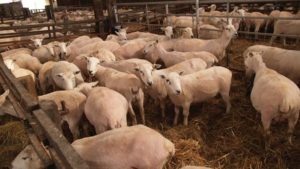Winter Housing And Shearing Of Ewes
20 December 2017 Housing ewes has positives and negatives. With the largest positive being that it prevents damage to the grass sward through poaching during the winter, this is especially relevant this year. But if ewes are being housed should they be shorn or left full fleeced?
Housing ewes has positives and negatives. With the largest positive being that it prevents damage to the grass sward through poaching during the winter, this is especially relevant this year. But if ewes are being housed should they be shorn or left full fleeced?
Positives
- Prevents damage by resting the grass, allowing for early growth in the spring.
- Feet problems in the ewes can be monitored, isolated and treated preventing spread.
- The space requirement per ewe can be reduced by 25% in late pregnancy when shorn, reducing housing space.
- Lambs can find the teat easier from shorn mothers and therefore suck quicker resulting in good early intakes of colostrum.
- The shorn ewe is clean underneath and at the back end reducing bacteria contamination when the lamb is searching for the teat.
- Easy to see which shorn ewes are bagging up and potential udder problems before lambing.
- Shorn ewes eat more forage (10-15%) resulting in lambs being 0.4 – 0.6kg heavier at birth.
Negatives
- Housing space (shed, polytunnel, slats, etc.)
- Bedding, availability of straw or alternative bedding sources.
- Warm, possibly moist atmosphere can cause feet issues.
- Additional cost of feed, straw and infrastructure.
- Mastitis and cold in shorn ewes if poor weather post turnout.
- Additional handling for shearing and possible stress when the ewes are in lamb.
Ideally
- Sheep are shorn the day they are housed. They must be dry for shearing.
- Leave thin sheep unshorn.
- Limit the forage intake for shorn single bearing ewes to prevent lambing difficulties.
- The shed must be draught free and well bedded.
- Shear the ewes at least 8 weeks before turnout to ensure wool growth.
Kirsten Williams, SAC Consulting Beef & Sheep Consultant
Sign up to the FAS newsletter
Receive updates on news, events and publications from Scotland’s Farm Advisory Service
